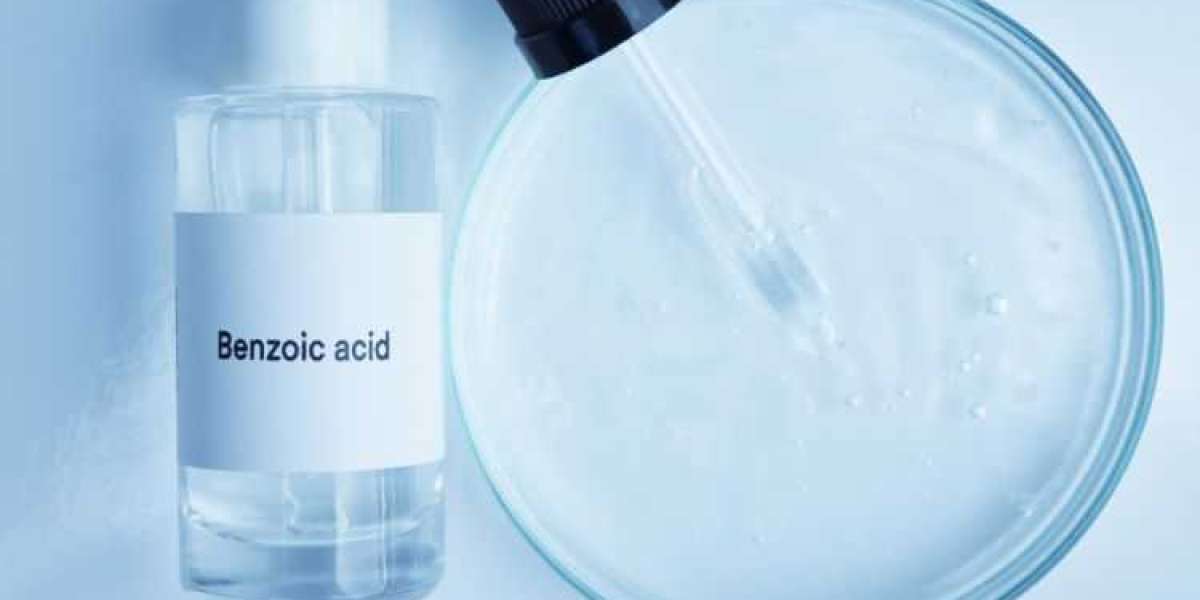The global benzoic acid market size attained a value of approximately USD 1.21 billion in 2023. The market is further expected to grow at a CAGR of around 5.50% in the forecast period of 2024-2032, reaching a value of around USD 1.96 billion by 2032. Benzoic acid, a versatile compound with diverse applications across industries, has witnessed significant growth in recent years. In this blog post, we delve into the trends, challenges, and prospects shaping the global benzoic acid market.
I. Historical Perspective:
Benzoic acid, a white crystalline solid with the chemical formula C6H5COOH, has a rich history dating back centuries. It was first isolated from benzoin resin in the 16th century by Nostradamus and subsequently synthesized in the 19th century. The commercial production of benzoic acid began in the late 19th century, primarily through the oxidation of toluene or benzyl chloride. Over the years, advancements in production methods, including the introduction of catalytic oxidation processes, have significantly enhanced the efficiency and scale of benzoic acid production.
The market for benzoic acid has evolved alongside developments in various industries, driven by its diverse range of applications. Initially used primarily as a food preservative, benzoic acid has found utilization in pharmaceuticals, plastics, perfumes, and other industrial sectors. The historical trajectory of the benzoic acid market reflects its adaptability and resilience in meeting the evolving needs of modern society.
II. Market Analysis:
The benzoic acid market is characterized by its broad application spectrum and geographical diversity. Key applications of benzoic acid include food preservatives, pharmaceuticals, plasticizers, dyes, and perfumes. As a food preservative, benzoic acid and its salts, particularly sodium benzoate, are widely used to inhibit the growth of bacteria and fungi, thereby extending the shelf life of various food products. In the pharmaceutical industry, benzoic acid derivatives serve as key ingredients in drug formulations, owing to their antimicrobial and antifungal properties.
Geographically, the market is segmented into regions such as North America, Europe, Asia-Pacific, Latin America, and the Middle East and Africa. North America and Europe have traditionally been significant markets for benzoic acid, driven by established food and pharmaceutical industries and stringent regulatory standards. However, the Asia-Pacific region, particularly China and India, has emerged as a major growth driver due to rapid industrialization, urbanization, and increasing consumer demand for processed foods and pharmaceuticals.
III. Trends Shaping the Benzoic Acid Market:
Several trends are shaping the current landscape of the benzoic acid market, influencing market dynamics and driving innovation. One notable trend is the growing demand for natural preservatives in response to consumer preferences for clean-label and organic products. This trend has led to the development of natural alternatives to synthetic preservatives, including plant-derived compounds and organic acids.
Technological advancements in production processes have also contributed to the evolution of the benzoic acid market. Traditional methods of benzoic acid production, such as toluene oxidation, have been augmented by catalytic oxidation processes and biotechnological approaches. These advancements have improved the efficiency, cost-effectiveness, and environmental sustainability of benzoic acid production, addressing concerns related to resource consumption and waste generation.
Another significant trend is the increasing emphasis on environmental sustainability and corporate social responsibility within the benzoic acid industry. Manufacturers are adopting sustainable practices, such as utilizing renewable feedstocks and implementing green chemistry principles, to minimize their environmental footprint and reduce greenhouse gas emissions. Additionally, efforts are underway to optimize production processes and enhance energy efficiency, further contributing to sustainability goals.
IV. Market Drivers:
The growth of the benzoic acid market is driven by several key factors, including the increasing demand for processed food and beverages. As consumer lifestyles become more hectic, there is a rising preference for convenience foods and ready-to-eat meals, necessitating effective preservation methods to maintain product quality and safety. Benzoic acid and its derivatives play a crucial role in preserving food freshness and preventing spoilage, thereby meeting the demand for longer shelf life and convenience.
In the pharmaceutical industry, the expanding global population, coupled with the prevalence of infectious diseases, drives the demand for pharmaceutical formulations containing benzoic acid derivatives. Benzoic acid exhibits antimicrobial and antifungal properties, making it a valuable ingredient in topical ointments, oral suspensions, and other pharmaceutical products. Moreover, ongoing research and development activities are exploring new therapeutic applications of benzoic acid derivatives, further fueling market growth.
Additionally, the growth of end-use industries in emerging economies, particularly in the Asia-Pacific region, presents lucrative opportunities for market expansion. Rapid urbanization, rising disposable incomes, and changing consumer preferences contribute to increased demand for packaged foods, beverages, and personal care products, driving the adoption of benzoic acid as a preservative and functional ingredient.
V. Market Challenges:
Despite the positive growth prospects, the benzoic acid market faces several challenges that may impact its trajectory. One significant challenge is the stringent regulatory standards governing the use of benzoic acid and its derivatives in food and pharmaceutical applications. Regulatory agencies, such as the U.S. Food and Drug Administration (FDA) and the European Food Safety Authority (EFSA), impose strict limits on the permissible levels of benzoic acid in food and beverage products, necessitating compliance with safety and quality regulations.
Fluctuating prices of raw materials, such as toluene and benzyl chloride, pose another challenge for market players. The volatility of raw material prices, influenced by factors such as supply-demand dynamics and geopolitical events, can impact production costs and profit margins, affecting the overall competitiveness of benzoic acid manufacturers.
Moreover, the benzoic acid market faces competition from alternative preservatives and antimicrobial agents, including sorbic acid, propionic acid, and essential oils. These alternatives may offer similar antimicrobial properties with perceived advantages in terms of safety, stability, and consumer acceptance, posing a threat to the market share of benzoic acid-based preservatives.
VI. Future Outlook:
Despite the challenges, the benzoic acid market exhibits promising growth prospects driven by emerging opportunities and evolving market dynamics. Forecasts suggest continued expansion, propelled by factors such as population growth, urbanization, and changing consumer preferences. The Asia-Pacific region is expected to remain a key growth driver, supported by robust economic growth, increasing investments in food and pharmaceutical industries, and favorable regulatory environments.
Innovation and technological advancements will play a crucial role in shaping the future of the benzoic acid market. Manufacturers are investing in research and development activities to develop novel production processes, enhance product performance, and address sustainability concerns. Biotechnological approaches, such as microbial fermentation and enzymatic synthesis, offer promising alternatives to traditional chemical methods, enabling the production of benzoic acid from renewable feedstocks with reduced environmental impact.
Moreover, strategic collaborations and partnerships between industry stakeholders, research institutions, and government agencies are expected to drive innovation and accelerate market growth. By leveraging synergies and expertise across the value chain, stakeholders can address common challenges, overcome barriers to market entry, and capitalize on emerging opportunities.








